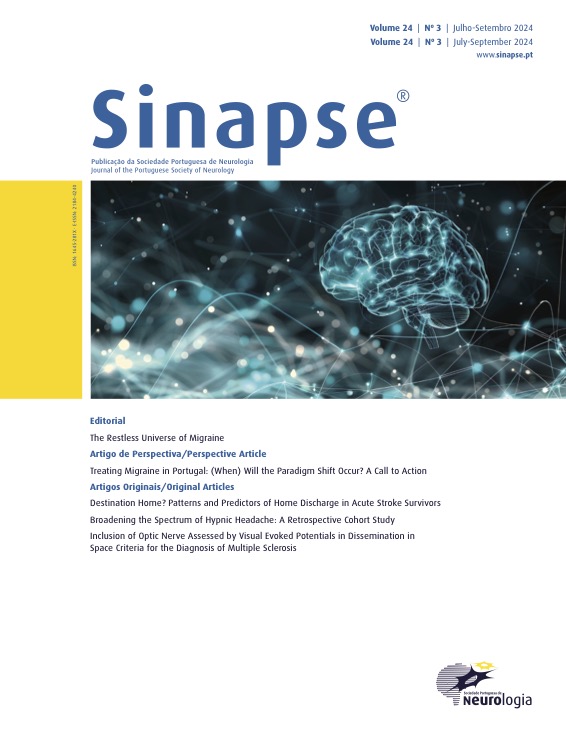Destination Home? Patterns and Predictors of Home Discharge in Acute Stroke Survivors
DOI:
https://doi.org/10.46531/sinapse/AO/240005/2024Keywords:
Patient Discharge, Stroke RehabilitationAbstract
Introduction: Stroke is a leading cause of permanent disability, often requiring participation in a specialized and personalized rehabilitation program following the event. Around 30% of stroke survivors experience ongoing disabilities that require extensive support from families and healthcare providers. However, there is a gap in national literature on discharge planning and care coordination for these patients, as well as predictive factors for their ability to return home after a stroke. The primary aim of this study was to describe the hospital discharge outcome of patients admitted with acute stroke. Secondary objectives included a descriptive analysis of their demographic profile, risk factors, acute phase treatment, and length of hospitalization, as well as identification of predictors of destination at discharge.Methods: A retrospective cohort study of patients admitted with acute stroke during 2021 was performed, including a descriptive analysis of the demographic and clinical characteristics, and post-hospital discharge destination. Non-parametric tests were used for association analysis, and linear regression was used to identify predictors of home discharge.
Results: Two hundred and four patients were included. The majority were discharged home with or without outpatient rehabilitation (55.4%). Significant predictors of destination of discharge included age, previous history of stroke, nasogastric tube feeding need on admission, vesico-sphincteric abnormalities on admission, National Institutes of Health Stroke scores (NIHSS) ≤10 on admission and after acute treatment, and ≤ 7 days stays on the stroke unit. Sex, the type of stroke, Trial of Org 10172 in Acute Stroke Treatment classification (TOAST) or Oxfordshire Community Stroke Project (OCSP) classifications did not appear to have a discernible association with discharge destination.
Conclusion: These results help to understand the factors that influence discharge home after stroke, as well as the ability to predict discharge home. This is critical information for optimizing the rehabilitation of stroke survivors, reducing the length of hospital stays and associated costs.
Downloads
References
Béjot Y, Bailly H, Durier J, Giroud M. Epidemiology of stroke in Europe and trends for the 21st century. Presse Med. 2016;45:e391-e398. doi: 10.1016/j.lpm.2016.10.003.
Moutinho M, Magalhães R, Correia M, Silva MC. Avaliação da Via Verde do Acidente Vascular Cerebral no Norte de Portugal: Caracterização e Prognóstico dos Utilizadores. Acta Med Port. 2013;26:113-22.
Direção Geral de Saúde. Programa Nacional para as Doenças Cérebro-Cardiovasculares 2017. Lisboa: DGS; 2017.
GBD 2019 Diseases and Injuries Collaborators. Global burden of 369 diseases and injuries in 204 countries and territories, 1990-2019: a systematic analysis for the Global Burden of Disease Study 2019. Lancet. 2020;396:1204-22. doi: 10.1016/S0140-6736(20)30925-9. Erratum in: Lancet. 2020;396:1562. doi: 10.1016/S0140-6736(20)32226-1.
Direção Geral de Saúde. Médicos do Sistema Nacional Saúde. Lisboa: DGS; 2011.
Dutrieux RD, van Eijk M, van Mierlo ML, van Heugten CM, Visser-Meily JM, Achterberg WP. Discharge home after acute stroke: Differences between older and younger patients. J Rehabil Med. 2016;48:14–8. doi: 10.2340/16501977-2045.
Vluggen TP, van Haastregt JC, Tan FE, Kempen GI, Schols JM, Verbunt JA. Factors associated with successful home discharge after inpatient rehabilitation in frail older stroke patients. BMC Geriatr. 2020;20:25. doi: 10.1186/s12877-020-1422-6.
Ottiger B, Lehnick D, Pflugshaupt T, Vanbellingen T, Nyffeler T. Can I Discharge My Stroke Patient Home After Inpatient Neurorehabilitation? LIMOS Cut-Off Scores for Stroke Patients “Living Alone” and “Living With Family”. Front Neurol. 2020;11:601725. doi: 10.3389/fneur.2020.601725.
Meijer R, van Limbeek J, Kriek B, Ihnenfeldt D, Vermeulen M, de Haan R. Prognostic social factors in the subacute phase after a stroke for the discharge destination from the hospital stroke-unit. A systematic review of the literature. Disabil Rehabil. 2004;26:191-7. doi:10.1080/09638280310001636437.
Lindenberg K, Nitz JC, Rahmann A, Bew P. Predictors of discharge destination in a geriatric population after undergoing rehabilitation. J Geriatr Phys Ther. 2014;37:92-8. doi: 10.1519/JPT.0b013e3182abe79e.
Spruit-van Eijk M, Zuidema SU, Buijck BI, Koopmans RT, Geurts AC. Determinants of rehabilitation outcome in geriatric patients admitted to skilled nursing facilities after stroke: a Dutch multi-centre cohort study. Age Ageing. 2012;41:746-52. doi: 10.1093/ageing/afs105.
Kalra L, Smith DH, Crome P. Stroke in patients aged over 75 years: outcome and predictors. Postgrad Med J. 1993;69:33-6. doi: 10.1136/pgmj.69.807.33.
Mees M, Klein J, Yperzeele L, Vanacker P, Cras P. Predicting discharge destination after stroke: A systematic review. Clin Neurol Neurosurg. 2016;142:15-21. doi: 10.1016/j.clineuro.2016.01.004.
Downloads
Published
How to Cite
Issue
Section
License
Copyright (c) 2024 Pedro Freixo Ribeiro, Joana Alberto, Joana Romano, Ursula Martins, Raquel Vilela

This work is licensed under a Creative Commons Attribution-NonCommercial 4.0 International License.








